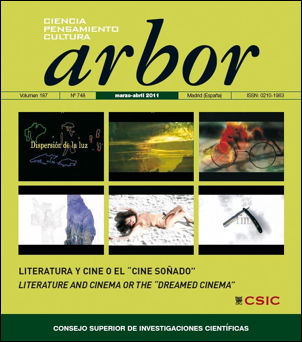Genre determinations in the adaptative processes
DOI:
https://doi.org/10.3989/arbor.2011.748n2010Keywords:
Adaptation, film, literature, genresAbstract
The translation of a literary text to the screen is usually conditioned by many factors derivated from the new context in which the adapted title must work. Among these we can count the conditions imposed on the original text by the cinematographic genre serving as a model in the translation process. This paper examines the problem and analizes three spanish films of the postwar period in which the literary work experiments an important transformation to adapted to exigences of cinematographic model.
Downloads
References
AA.VV. (2005): La nueva memoria. Historia(s) del cine español, Coruña, Vía Láctea.
Anónimo (1945): “Un realizador entra en campo. Arturo Ruiz-Castillo va a dirigir películas largas. Y para comenzar ha descubierto una nueva cantera cinematográfica: Baroja”, Luces. Revista de Espectáculos, II, n.º 4, febrero.
Alonso Barahona, Fernando (2004): Rafael Gil. Escritor de cine, Madrid, Egeda.
Altman, Rick (2000): Los géneros cinematográficos, Barcelona, Paidós.
Becerra, Carmen (ed.) (2005): Lecturas: Imágenes. Reescribir ficciones. Imágenes de la literatura en el cine y en la televisión, Pontevedra, Mirabel.
Catrysse, Patrick (1992): Pour une théorie de l’adaptation filmique. Le film noir américain, Berna, Peter Lang.
Cerón Gómez, Juan Francisco (1998): El cine de Juan Antonio Bardem, Murcia, Universidad y Primavera Cinematográfica de Lorca.
Coremans, Linda (1990): La transformation filmique. Du “Contexto” a “Cadaveri eccelenti”, Berne, Peter Lang.
Heredero, Carlos F. (1993): Las huellas del tiempo. Cine español 1950-1961, Madrid y Valencia, Filmoteca Española y Filmoteca de la Generalitat Valenciana.
Martí, Daniel (2005): “Restos útiles del debate en torno al género cinematográfico”, en Carmen Becerra (ed.), pp. 435-447.
Naremore, James (ed.) (2000): Film Adaptation, New Brunswick, Rutgers University Press.
Paz Otero, Héctor (2008): Adaptaciones cinematográficas en la década de los cuarenta de las novelas de Wenceslao Fernández Flórez ambientadas en Galicia, Tesis doctoral inédita presentada en la Universidad de Vigo.
Peña Ardid, Carmen (ed.) (1999): Encuentros sobre literatura y cine, Teruel y Zaragoza, Instituto de Estudios Turolenses y Caja de Ahorros de la Inmaculada.
Pérez Bowie, José Antonio (2006): “La novela de Pío Baroja en el cine”, Ínsula, 719, noviembre, pp. 33-36.
Pérez Bowie, José Antonio (2007): “Alfonso Sastre en el cine. Algunas notas a propósito de La cornada y su versión fílmica (A las cinco de la tarde, de Juan Antonio Bardem)”, República de las Letras, 101, pp. 98-112.
Ropars-Wuilleumier, Marie-Claire (1975): Du la littérature au cinéma, Paris, Armand Collin.
Ropars-Wuilleumier, Marie-Claire (1981): Le texte divisé, Paris, PUF.
Ropars-Wuilleumier, Marie-Claire (1990): Écraniques. Le film du texte, Lille, Presses Universitaires.
Salvador Marañón, Alicia (2006): De Bienvenido, Mr. Marshall a Viridiana. Historia de UNINCI, una productora cinematográfica bajo el franquismo, Madrid, Egeda.
Schaeffer, Jean Marie (1989): Qu’est ce qu’un genre littéraire?, Paris, Seuil.
Serceau, Michel (1999): L’adaptation cinématographique des textes littéraires. Théories et lectures, Liege, Éditions du Céfal.
Stam, Robert (2000): “Beyond Fidelity: The Dialogics of Adaptation”, en James Naremore, ed., pp. 54-76.
Stam, Robert (2005). “Introduction: The theory and Practice of Adaptation”, en R. Stam & Alessandra Raengo (eds.), pp. 11-52.
Stam, Robert & Alessandra Raengo (eds.) (2005): Literature and Film. A Guide to Theory and Practice of Film Adaptation, London, Blackwell.
Vanoye, François (1989): Récit écrit et récit filmique, Paris, Nathan.
Vanoye, François (1996): Guiones modelo y modelos de guión. Argumentos clásicos y modernos en el cine, Barcelona, Paidós.
Villanueva, Darío (1999): “Novela y cine, signos de narración”, en Peña-Ardid, Carmen (ed.), pp. 185-209.
Zunzunegui, Santos (2005): “Epílogo: La línea general o las vetas creativas del cine español”, en AA.VV., pp. 488-504.
Downloads
Published
How to Cite
Issue
Section
License
Copyright (c) 2011 Consejo Superior de Investigaciones Científicas (CSIC)

This work is licensed under a Creative Commons Attribution 4.0 International License.
© CSIC. Manuscripts published in both the printed and online versions of this Journal are the property of Consejo Superior de Investigaciones Científicas, and quoting this source is a requirement for any partial or full reproduction.
All contents of this electronic edition, except where otherwise noted, are distributed under a “Creative Commons Attribution 4.0 International” (CC BY 4.0) License. You may read the basic information and the legal text of the license. The indication of the CC BY 4.0 License must be expressly stated in this way when necessary.
Self-archiving in repositories, personal webpages or similar, of any version other than the published by the Editor, is not allowed.














